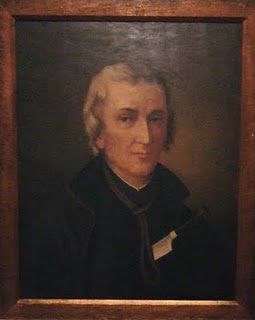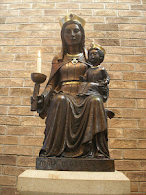This year marks the 339th anniversary of the martyrdom of St David Lewis. Abergavenny born David Lewis was a Jesuit priest who risked life and limb ministering to the embattled Catholics of Monmouthshire and surrounding areas during the dreadful days of Penal Laws against Catholics. It was against the law to be a Catholic and those who chose to stubbornly stay loyal to the "Old Faith" did so at great financial as well as personal risk. To be a Catholic Priest was considered High Treason and, if found guilty, the punishment was to be hanged, drawn and quartered.
 |
| St David Lewis, Llantarnam Abbey (Photo J D Smith) |
Monmouthshire Member of Parliament, John Arnold, was certainly not one of those tolerant men. Indeed, he was a fanatical anti-Catholic and rabid priest hunter. He was determined to root out Catholicism from every corner of the country.
Although Arnold feigned friendship with Fr David Lewis, he played the main part in the downfall of the priest. Unlike Arnold, Fr Lewis was a kind and gentle man who was greatly loved. For his kindness to all, he was know as "Tad y Tlodion", "Father of the poor".
On Sunday morning, 29th November 1678, as Fr Lewis prepared to celebrate Mass, Arnold's lackeys arrested him. (For more on his arrest, click here) He was first taken to Abergavenny and then to Arnold's home, Llanvihangel Court, Llanvihangel Crucorney, about 5 miles from Abergavenny. Here David Lewis spent his first night in captivity before being taken to Monmouth Gaol where he was incarcerated.
In 1679, on a cold and utterly miserable January day, The good priest was moved to Usk Gaol. Eventually, on 27th August 1679, Father David Lewis S J, was executed at Usk. It is a testimony to the high esteem in which he was held that he was given a respectful burial in the churchyard of the Anglican Priory of St Mary, Usk. David Lewis was canonised in October 1970 by Pope Paul VI. It is true that we give glory to God by honouring His saints and, even today, many people visit this saint's grave to pay homage to his courage and steadfast faith and to ask his prayers for their own needs.
 |
| Llanvihangel Court (Photo J D Smith) |
 |
| The Saint's grave (Photo J D Smith) |
When we visited several years ago there wasn't much said of John Arnold's nefarious deeds. St David Lewis wasn't spoken of at all. As I said, it is a few years since we visited and it might be different now. We did ask questions about St David Lewis and the night he spent there so perhaps he now gets a mention. You never know!
I am not touting for business for Llanvihangel Court but it is an awesome feeling, as well as a great privilege, to find yourself in a house where once a holy man, who gave his life for the Catholic faith and the Mass, was briefly lodged.
 |
| The Becket Window, Christ Church, Oxford (Photo J D Smith) |








.JPG)

.JPG)



.JPG)


No comments:
Post a Comment